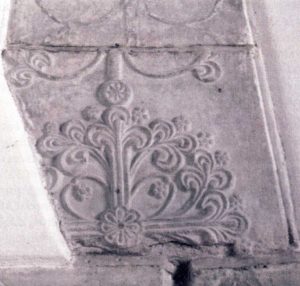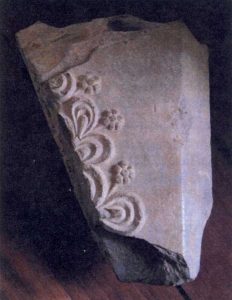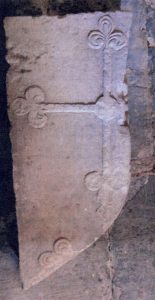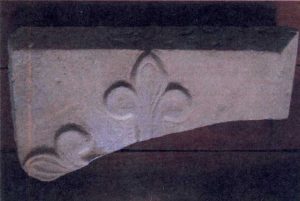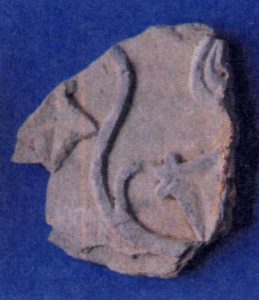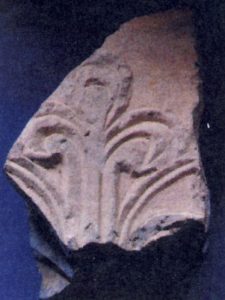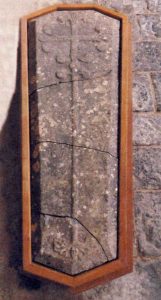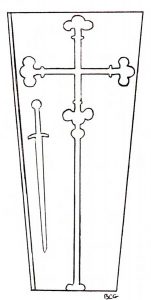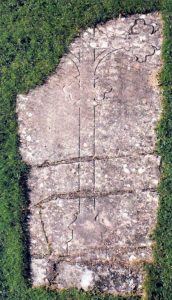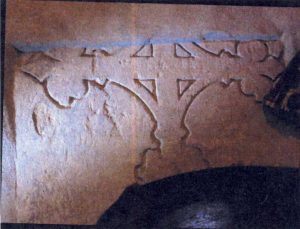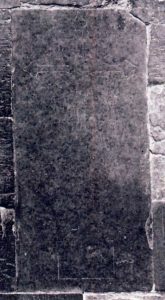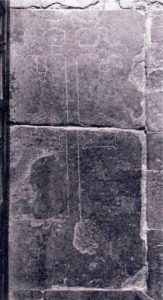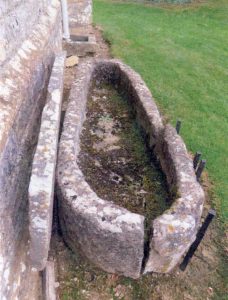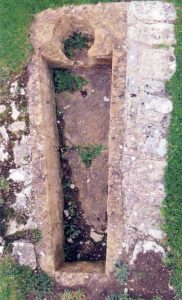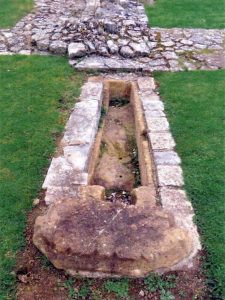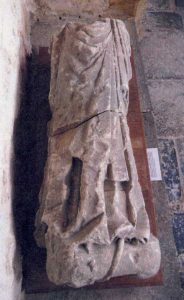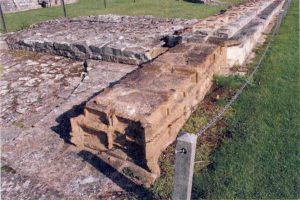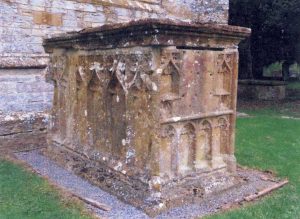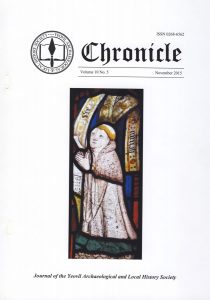
This article came from the Chronicle published November 2015. Pages 148-163
COMMEMORATION AT MUCHELNEY BEFORE THE REFORMATION
Authors: Brian & Moira Gittos
Introduction
Muchelney Abbey is an English Heritage run property in the heart of the Somerset levels (Plate 154). Famously, this great island (which is what the name means) is cut off by water every time the levels flood.1 Before the great drainage enterprises of the seventeenth century, this situation must have obtained for most of the year, to a greater or lesser extent. The abbey’s site occupies the highest point of the island and remains clear of the flood waters but the situation would, in the medieval period, have made it a remote spot and it is easy to see why it would have been considered suitable for an early monastic foundation. Traditionally it is thought to have been founded by King Ine in 693 but no original documentation survives. However, there was certainly a religious community there by 762, attested by a surviving charter from King Cynewulf.2 This will have been a minster church, served by a community of clergy.3 The house claimed to have been refounded by King Athelstan in 939 but this document, like those of King Ine, is a forgery. However, Muchelney seems to have become a Benedictine Abbey in the mid-tenth-century, at the time when many monasteries in England were adopting the Rule of St Benedict in response to its promotion by St Dunstan, Abbot of Glastonbury from before 940 until 957 and Archbishop of Canterbury from 960 until his death in 988.4
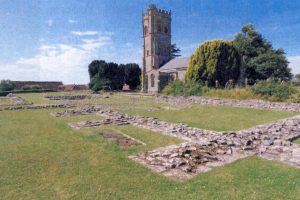
Whilst owning considerable property, Muchelney was never a large abbey although, in proportion to its number of monks, it was well endowed. Estimates of its greatest extent have varied. The Victoria County History, without quoting its sources, gave the figures of thirteen monks in 1463; fifteen in 1489 and eight in 1538 (in addition to the Abbot and Prior).5 The figure at the Dissolution has also been quoted as ten in addition to the Abbot.6 Robert Dunning quotes the figures of seventeen monks in 1381, thirteen in 1463, fifteen in 1489 and eleven in both 1534 and at its surrender in 1538.7 All in all, it seems likely that there were never more than twenty monks in the later middle ages. Its size in the pre-Conquest period could only be a matter for conjecture but the 2011 Guide suggests that the community is unlikely ever to have numbered more than forty.8 But the figures do suggest a gradual decline in the spiritual attractiveness of Muchelney for novice monks across the fifteenth century. The cause of this is difficult to determine but Muchelney was not alone in witnessing such a decline. In some establishments, lack of recruits, combined with a decline in their financial positions, led to closure or amalgamation with other monasteries, well before the Dissolution under Henry VIII.
The situation at Muchelney was nothing like that at the monasteries which did not survive and this is most clearly shown by the Abbey’s income which increased during the later middle ages, rather than declining. In 1291, Muchelney’s estates were valued at £38 8s 6d. By the time the abbey was assessed for the Valor Ecclesiasticus, just before the Dissolution of the Monasteries, its annual revenue amounted to £447 4s 11d and, in terms of wealth ranked fourth in Somerset, exceeded only by Glastonbury (probably the wealthiest monastery in the whole country), Bath and Montacute.9 The average income of a monastery in England at this assessment was less than £200.10 So if Muchelney’s wealth was only needed to support a declining community, how was it used? One answer may lie in the date of the surviving buildings. The principle building as we now see the site, was the Abbot’s lodging and incorporates six bays of the cloister. Much of this dates from the fifteenth century and might be a clue to how the income was being spent.
In common with many other monasteries at the centre of communities, there was a parish church situated very close to the abbey church. At Sherborne, the parish church stood immediately west of the abbey church whereas at Muchelney, as at Abbotsbury, the churches lay alongside each other, with the parish church just to the north. A separate parish church meant that the monastic devotions need not be interrupted by services for the local people and at Muchelney a separate parish priest was provided who was not one of the Abbey’s personnel and who lived in a house in the village that was provided by the Abbot, with allowances of food and drink from the abbey kitchens and certain revenue out of the Abbey’s income.11 At seems as though the parish church was regarded as part of the Abbey but its day-to-day management was kept at arms length. This continuing responsibility is consistent with the Abbey’s origins as an Anglo-Saxon minster and the physical proximity of the two buildings.
At both Muchelney and Abbotsbury, it was the parish church that survived the Dissolution with the abbeys being razed to the ground. In both cases, there seems to have been no physical boundary between the parish church (including its churchyard) and the Abbey grounds. Indeed, at Sherborne, the parish church was actually attached to the west end of the Abbey church. By the end of the medieval period at least, Muchelney parish church was regarded as having its own churchyard. However, there is no doubt that the parish church would have continued to have a very close association with the Abbey and for this reason it seems logical to deal collectively with the monuments of both churches.
The end of the monastery came with its suppression in 1538, after which the church was rapidly dismantled, its useful materials sold off, and it was reduced to its foundations so thoroughly that even the location of the church was forgotten, with the surviving buildings being converted into a farm. So it was with some surprise that, in 1872, farm labourers moving a heap of ‘lime rubbish’, chanced on a depositof blue lias shafting and Ham Hill stone.12 Under this was one of the grave covers described below. Short periods of excavation were undertaken in 1873 and 1874, at the behest of the owner, Walter J. Long Esq. The site was taken into state guardianship 1927 and further excavations were undertaken between 1948 and 1952 under the direction of G. W. Dunning and R. Gilyard-Beer, but overseen by the Ministry of Works Custodian, Harold Hall. The earlier work had succeeded in tracing the layout of the Abbey church whereas the mid-twentieth century work uncovered, amongst other things, the remains of an Anglo-Saxon church, beneath the crossing of the later medieval building.13
Commemoration in the Abbey
Commemoration of the dead was a integral part of life at Muchelney Abbey, as it was in every monastery, cathedral and parish church across Christendom. Documentary evidence is available from as early as c.1200, when Constance de Dunpole gave land to the abbey in return for the community’s prayers for the safety of her soul and those of all her ancestors and successors and [the soul] of Peter her son whom she offered to serve God in the same church, under the monastic order.14 The pages of the Muchelney Cartulary are full of such gifts but, since this is a late thirteenth-century document only sketchily updated later, it does not contain many details of such gifts for the fourteenth or fifteenth centuries although some information for that period can be found in the Muchelney Breviary.15 However, the information can be supplemented from other sources, such as surviving wills. The evidence suggests that, as elsewhere, commemoration was a very broad spectrum indeed. It ranged from small sums of money to fund a lamp or gifts of chattels right up to burial in the abbey church or the foundation of perpetual chantries.
Amongst the provisions of particular interest is the, sadly undated but probably thirteenth century, gift of ‘messuage with curtilage in “Puthlane” in Gyvele which is a tenement of the greater church of that town’. This was given by Geve de Hurste, wife of Peter de Northfuk, ‘for the safety of her soul & that of her husband.16 The property, which they clearly leased from St John’s, was in the road that was to become known as Middle Street. Muchelney Abbey would have been able to let the property and the rent would have provided income. Geve de Hurst, like Constance de Dunpole, would have expected that she and her husband would be prayed for by the community in return. There is no indication where Geve or Peter de Northfuk were to be buried but these requests did not carry an expectation that the benefactors would be buried at Muchelney (although they might). In the case of Henry de Urtiaco, he probably was not. Henry de Urtiaco married Sabina, the daughter and heiress of Richard de Revel the younger, Lord of Langport. Later in the thirteenth century and at the beginning of the fourteenth, the family seem to have been buried at Curry Rivel and to be commemorated by the great series of monuments in the north chapel. His grant to Muchelney is undated but since he died in 1242, it must be earlier.17 He gave certain privileges to the Abbey’s tenants, ‘for the safety of his soul, the souls of his parents, Sabina, his wife, his heirs and for the souls of Richard Revel, the elder, and Richard Revel, the younger and Mabel, his wife, and of his own ancestors and successors’.18 People who chose monastic intercession although not being buried in the abbey, were seeking to speed their passage through Purgatory by ensuring as many prayers as possible were said for them, consistent with their own resources. They usually left bequests to a range of monasteries and other churches, often not too far from their homes but occasionally spread quite widely across the country. Some people chose to give goods rather than property or privileges. One such was John Glanvill, rector of Yeovil and Canon of Wells. In 1407, he asked to be buried in the churchyard of Yeovil but left a great many of his possessions to the Abbot. Clearly he was expecting the Abbot’s prayers.19
Occasionally, the documents give more specific details of what the benefactors had negotiated with the Abbey. In the middle of the thirteenth century, Sir Thomas des Leges, the lord of Hurst (near Martock) gave the abbey three shillings a year and the document says that,
Probably a little later, towards the end of the thirteenth century, Geoffrey de Scoylande gave an acre of land, for the safety of his soul and those of several relatives.21 The document sets out rather more clearly what might be expected in return for such a gift.
Benefactors names would be entered on a list kept by the abbey. At regular intervals, the names would be read aloud in the church and prayers would be offered for them. These lists could be called different things but most often known as bede rolls. Muchelney Abbey clearly called theirs a ‘Martyrology’. The concession to invoke prayers from across the country, in the same way as was done for deceased members of the order, is rather more exceptional and may have resulted from a long and close relationship with the abbey. Other people sought more lasting intercession by founding a perpetual chantry. In 1359, William Derby (chaplain) and Alexander de Caramel (clerk) gave the abbey the manor of Downhead (just to the north of the A303, in West Camel).22 The income from the manor was to be used to pay for a priest ‘to celebrate [mass] every day in the abbey for the healthful estate of Alexander while he shall live, and for his soul when he shall die, …. for ever’. They were setting up a perpetual chantry which they expected would last for until the end of the world.
There is nothing to suggest that any of the people mentioned so far were buried at the abbey but other cases are more clear cut. When Agnes Grene made her will in 1423, she asked to be buried before the altar of St Christopher and gave a silver basin to altar, presumably as her mortuary gift.23 When her husband William died four years later he too asked to be buried in the monastic church but without specifying a position.24 However, later in his will, he left vestments and a chalice to be used by ‘eachmonk … who shall celebrate [Mass] for the souls of William Grene and Agnes, his wife, and of Robert Sparry at the altar of St Elizabeth in the church of the said abbey shall use them there, to the honour of God, of the Blessed Virgin and St Elizabeth forever’. There is also a small glimpse of what his funeral was like in the provision for six named poor people to be at his obsequies at Muchelney and standing at the mass on the day of his anniversary, each dressed in the gown and hood of russet which he had provided for them.
Two further burials are of interest. Ina document of 1226, Richard son of Hamon de Ivelcestria acknowledged that he and his heirs were bound to give 1 lb wax to St Peter at Muchelney for the souls of their ancestors, whose bodies lie there.25 This was presumably in fulfilment of a commitment made some time previously and in respect of more than one burial which had taken place at the very beginning of the thirteenth century, at the latest. The final burial to be discussed is that of Richard de Revel senior, who ‘was translated and buried before the altar of the Holy Cross in the greater church of Muchelney’ in 1215. Between 1208 and 1214, as the result of a dispute between King John and the Pope (over the appointment of a new Archbishop of Canterbury), England was placed under Interdict which meant a suspension of all church service and the only sacraments that were permitted were the baptism of infants and the administration of viaticum (a final holy communion) to the dying.26 No one was permitted Christian burial – burial in consecrated ground. Consequently, those who died were buried in unconsecrated ground with the expectation that they would be moved once the Interdict was lifted. This seems to be exactly what happened to Richard de Revel senior, when he was finally buried at Muchelney some two years or so after he died.
The Surviving Monuments
Section A Grave Slabs
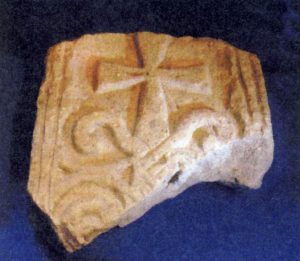
A1 This fragment of a cross slab / grave cover (Plate 155), is now displayed in a cabinet in the south cloister walk but its discovery does not appear to have been recorded. It is difficult to decide whether the remaining portion is from the bottom of a much larger slab or from the top of quite a small monument. However, it is a tapered slab, carved in bas-relief with two crosses one above the other. One is a simple splayed arm cross and the other is more complex with a cross-hatched centre, curving tendrils and a surviving pierced arm. Both crosses are enclosed within a roughly moulded border. The vertical edges are roughly tooled with a broad chisel. It is difficult to find parallels for this early slab but it has been suggested that it may date from the late eleventh century.27 It is apparently carved in a variety of Blue Lias limestone.
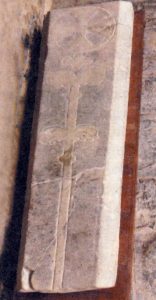
A2 This grave slab (Plate 156) is now exhibited on the floor of the south walk of the cloister but where it was found does not seem to have been recorded. It is carved in extremely low relief and the cross has a splayed-arm head within a circle, with a trefoil immediately below it. On the shaft are two pairs of broad leaves and below each is a small knop. There is no base as the bottom end of the slab is missing. It has a straight chamfered edge on all three surviving sides. The surviving length is 61 inches, tapering from 19 inches at the head end to 14½ inches at the lower end. It is 41½ thick and is of Blue Lias limestone. It probably dates from the late 12th or early 13th century to judge from the style of the cross head and the form of the leaves. The remarkable feature of this slab is the fact that the carver has made careful use of the stone he had selected, which had layers of light and dark stone. The dark layer has been locally cut away to leave the cross in the lighter buff coloured layer, dramatically contrasted with the dark layer. The technique is similar to that used for the creation of cameos, where coloured layers in gem stones, shell or glass are carved in bas-relief, to leave different parts of the design in different colours. The effect is to create a design which appears to have far greater depth than is actually true. In this stone, it seems that the lighter material is softer than the dark and so most of the cross is worn smooth except for the lower pair of leaves which retain their detailed modelling. This slab is illustrated in the current English Heritage guide.28
A3 This fragment is from the top end of a tapered cross slab carved in a very hard type of Blue Lias limestone which has broken in a brittle manner (Plate 157). It has a straight chamfered edge on the surviving sides and the remains of a cross head in relief, comprising the top terminal and part of the left one. They are made up of trefoils in a late style of thirteenth-century stiff leaf. The surface around the cross head is slightly dished which has the effect of enhancing its relief. The slab’s maximum width is about 22 inches and it is 4½ inches thick. It is not known where this slab was discovered and it is marked with the reference number 78900351.
A4 This is another fragment of a Blue Lias limestone cross slab, with a chamfered edge and part of the cross head carved in relief (Plate 157). Insufficient remains to judge its orientation but the cross head was of a very elaborate design comprising a late type of still leaf with fruit (or flowers) on stalks between the leaves. It is 4¾ inches thick and it strongly resembles some more complete pieces of grave slabs preserved in Limington church near Ilchester, particularly the head now set upside down in the centre of the group (Plate 157).29 Like those at Limington, the Muchelney piece probably dates from the third quarter of the thirteenth century. An old photograph published in the current abbey guide appears to show this piece displayed on the steps to the village cross.30 This is part of an assemblage of mostly architectural fragments from the nineteenth-century excavations but adjacent to it are a number of other similar pieces, not all of which are now to be seen at Muchelney. However, they look as though most of them could had come from the same slab, which had been broken into many pieces.
A5 This is a small Blue Lias limestone fragment, is probably from a cross slab, with just one spray of stiff leaf from the cross head, carved in relief (Plate 157). It appears to be another of the pieces shown in the old photograph of finds from the nineteenth-century excavations (see A4 above). However, it does not exhibit the fruit (or flowers) shown on fragment A4 and probably comes from a different same slab. It probably dates from the third quarter of the thirteenth century.
A6 This is a small fragment of Blue Lias limestone, probably from a cross slab, with detail in relief (Plate 157). This consists of a sprig of naturalistic ivy leaves and the tip of a form of stiff leaf. It is not recorded where it was found and it probably dates from the last quarter of the thirteenth century when the use of naturalistic foliage was employed on both architectural details and monuments.
A7 Loose on the floor below the tower of the parish church is a piece of a tapered Blue Lias limestone grave slab with part of a cross head in relief and no chamfer to the edges of the slab (Plate 157). The maximum surviving length is 28½ inches, but it would originally have been about 21 inches wide at the head end and is 4½ inches thick. The cross is straight armed, with a circular centre (which may originally have been carved with a flower). The cross terminals are of the stiff leaf foliage with two curled leaves and a rounded bud which has a single vein running into it. It appears to be the top left corner of the slab as lower down there is another leaf which presumably relates to a branch coming off the cross shaft. A characteristic feature of typical thirteenth-century stiff leaf is a central vein plunging into the bud. In this case it simply lies on top of the bud suggesting that it is a late form of stiff leaf. The straight arm cross with a disc centre is seen on Purbeck marble cross slabs of the late thirteenth century and flowers are found at the cross centre of the slabs at Limington. This example probably dates from the last quarter of the thirteenth century. It is likely to have come from the abbey site but nothing is known about its discovery.
Plate 157 Blue Lias Slabs All photos B&M Gittos
Plate 157 All photos and drawings B&M Gittos
A8 This complete cross slab is now displayed on the floor of the south cloister walk. It is badly broken and kept together by a purpose-built wooden frame (Plate 158). It is made of Blue Lias limestone with the cross carved in relief. The cross head is straight armed with trefoil terminals comprising pointed buds between a pair of leaves, with a tie at the point where the leaves emerge from the arms. The shaft has a round knop and a single pair of leaves below it. The cross base comprises two sprigs of leaves of worn and indistinct form. The slab is 75 inches long and tapers from 28 inches wide at the head end to 17½ inches at the foot. The thickness is 4½ inches and the edges have a hollow chamfer. Unusually, both ends of the slab are multi-sided, with two at the base and three at the head end. In 1990 this slab was still out on site, in the abbey’s graveyard on the south side of the Lady chapel between the easternmost two buttresses. The position is still marked by a wooden frame. This probably indicates that a burial was found here and that this was the slab’s original location. It does show some signs of weathering and probably dates from the late thirteenth century.
A9 This complete cross slab of Blue Lias limestone (Plate 158) is on the excavated site at the east end of the north aisle of the nave beside the entrance to the north transept. However, it is unlikely to be in situ because there is a chamfer down one side only suggesting that it was originally located in a recess, where the other three sides would have been against walls. It is 76½ inches long and tapers from 31¼ inches at the head end to 21½ inches at the foot. The detail is lightly incised and comprises a straight arm cross with trefoil terminals and another trefoil for the base. On the left side of the cross is a sword 46 inches long, with depressed quillons and a round pommel. Such symbols are very common on cross slabs in the north of England but rarely seen in the south west. The general layout of this slab strongly resembles that of another Blue Lias slab found by excavation in situ on the site of the earlier church at Shapwick.31 The church at Shapwick was replaced by a new church on a different site in 1330 and so the slab must predate that event. The Muchelney example probably dates from the period either side of 1300, when simple straight arm crosses of this type were in vogue.
Unfortunately, the shallowness of the carving and the extent of lichen growth on the slab mean that it is very difficult to discern the design, except in sharply raking light. Since the lightness of the incising seems to be an original feature, rather than the result of wear, this would always have been a problem. The most likely explanation is that the incising was complimented with paint, picking out the features. The paint would have been lost over time. It might also have been used to provide an inscription naming the person commemorated. Even without an inscription, it is possible to deduce something of the person commemorated. To want a sword represented on a memorial, the person concerned must have been male and it is likely that the use of a sword was a significant element of their lives. (It is possible, but far less likely, that they were a swordsmith.) However, the depiction of a sword does not mean that the commemorated has to have been a knight. For instance, a slab with a sword in St John’s church, Chester commemorates John Le Seriaun who seems to have been one of the City Serjants and was not a knight, with the sword acting as a badge of office.32 It could be argued that if the person were knighted, the emblem of choice would be a shield bearing his heraldry, which would identify the person to be remembered in the absence of an inscription. However, it is possible that either or both a shield and an inscription were provided in paint. Another aspect for consideration is the likelihood that the slab was set up in a recess. This means that it was part of a much more elaborate monument and one that would have entailed an alteration to the fabric of the building. This would not have come cheaply and means that the person involved must have had the means. Against this background, it is sad that it has not been possible to equate this monument with any of the known burials in the church, such as Sir Richard de Revel in 1215, but the slab is much later in date.
A10 The location of this cross slab, on the floor of the north ambulatory of the choir, is marked on the earliest published plan of 1879 and it is probably in situ.33 It is badly broken and has been cemented back to together (Plate 158). The top left corner is missing and there appears to have been more of the slab lost from the bottom end. It is of Blue Lias limestone with a large, boldly incised, cross. It has a straight arm cross head with curved bracing between each arm and large foliate terminals. Each terminal has a small knop immediately behind it and there is a sharply pointed knop just below the cross head. The base has a complex architectural form like the stilted base of a Perpendicular pillar. The present length, which is made uncertain by the repairs, is 68½ inches and the slab tapers from about 39½ inches at the middle of the cross head to 32 inches at the present base. The form of the cross head terminals seems to have been employed over a long period from the late fourteenth century through to the early sixteenth but the degree of taper on this slab would suggest that it should be one of the earlier examples.
Plate 158 All photos and drawings B&M Gittos
Plate 158 All photos and drawings B&M Gittos
A11 Part of a Ham Hill stone cross slab with a very similar head design to A10 is now built into the north interior wall of the parish church acting as part of the head of the north door way (Plate 158). It is an example of a monument being cut up and recycled for building material. The deeply incised design is very close in detail to slab A 10 and is notable for still displaying one of the setting out lines which the mason used when cutting the cross head. One interesting aspect is that despite their similarities, the two slabs are of different materials, with this being Ham Hill stone whereas A10 is Blue Lias. The parish church is described in the revised Pevsner as ‘wholly late 15th century’ and so this slab is probably contemporary with A10, although it may have been always been associated with the parish church.34 Its re-use should be seen as a consequence of the fifteenth century rebuilding.
A12 The grave slab which is now set in the floor of the tower of the parish church (west of the font) came originally from the abbey site. It was one of the first things found when digging began in the winter of 1872.35 From the published account, it would appear that it was found in the Lady Chapel, upside down near the north wall and lying on a floor of encaustic tiles, which it had helped to preserve and which are now set in the sanctuary floor of the parish church. The slab is incised with a crosier and there is no other detail (Plate 158). It is of Blue Lias limestone, 74½ inches long and tapering from 38½ inches at the head end to 32 inches at the foot. The crosier has been very simply, and rather inexpertly, represented on the stone. At the bottom end it has a pointed tip with a rectangular knop, while the crosier head is in the form of a loop with irregularly spaced angular crockets above another rectangular knop, which has pointed ends. Within the loop is a very worn and irregularly profiled flower head, rather like a Tudor rose. There is evidence of a clumsy attempt to cut away the background round the flower head, which would have shown it in relief, but the carver seems to have abandoned this task after only a few blows of the chisel. It is of course possible that the limitations of the carver were compensated for by a more accomplished painted design using this as just an outline drawing. An interesting comparison for the general form of the crosier head is the oak example found in a grave St Stephen’s Chapel, Westminster, in 1852 and believed to be that of William Lyndewode, Bishop of St. Davids, who died in 1446. An even later example is the brass to Abbot Richard Beauforest (who died in 1510) at Dorchester Abbey, Oxfordshire.36 He carries a crosier which has a head of comparable shape to Muchelney and a similar flower in the centre. The tapered shape of the Muchelney slab may indicate that is earlier in date – perhaps an abbot of the second half of the fourteenth century. Thomas Overton who died in 1370 is therefore a good candidate but William de Shepton (d. 1397/8), Nicholas Stratton (d. 1400), John Bruton (d. 1432), John Cherd (d.1463) etc might also be possibilities.
A13 Set in the floor of the centre aisle of the nave, in the parish church, is a rectangular slab of Blue Lias, 71¾ inches by 36 inches, which has a simple incised cross with a straight arm head and trefoil terminals with pointed buds (Plate 158). It has a rectangular base with a moulded upper edge and there is no trace of an inscription. Its plainness makes it difficult to date but it probably belongs to the fifteenth or early sixteenth century and may always have been in the parish church.
A14 Immediately to the west of A13, in the nave floor of the parish church, is a very large rectangular slab in two pieces. It is 95 inches long and about 44 inches wide, with the left edge beneath the pews. It is of Blue Lias limestone and is incised with a straight arm cross having large, florid, non-foliate terminals (Plate 158). It has an enormous four-step base, of which the top three steps have hollow moulded corners. To either side of the cross are two curious features, rather like caskets with hipped lids, which appear to be frames for inscriptions. These are worn and difficult to make out, made worse because the junction between the two halves of the slab runs across them. A few words can be made out in the left hand panel, sufficient to show that the script was reversed with respect to the cross. It is in English and reads ‘of all yo……’. It is possible that the inscription read continuously across both panels, beginning on the right hand side. Nothing quite like this slab is known to the authors and it probably dates from the sixteenth century. Again, it may always have been in the parish church.
A15 Set within the abbey crypt in the north east corner is a worn and broken tapered slab which has survived through being re-used in the structure. It is of Blue Lias limestone with a maximum surviving length of 63 inches, a maximum width of about 23½ inches and a thickness of 4 inches. It is now orientated north south and is shown on the excavation plan published in 1950, where it is labelled ‘re-used grave slab’. It is shown parallel with the base of the two steps down into the apsidal end of the Anglo-Saxon church cum crypt, as if forming part of the floor. However, as this area is now displayed, the steps are not present and the purpose of its re-use is less clear. It is devoid of detail and there is nothing to indicate its date.
Plate 159 All photos and drawings B&M Gittos
Plate 159 All photos and drawings B&M Gittos
Plate 160 All photos B&M Gittos
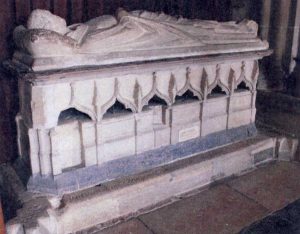
Plate 160 All photos B&M Gittos
Section B Effigy
B1 Now resting on a modern wooden plinth in the south walk of the cloister are the remains of an effigy of an ecclesiastic, lacking its head and shoulders (Plate 159). It was dug up in the small north east chapel situated in the angle between the north transept and the north choir aisle, during the 1874 excavations.37 It is carved from a fine grained white limestone with one large complete shell visible. What remains is about 55 inches long and the maximum depth is about 13½ inches, making for quite a bulky figure. It is broken across what is now its middle and appears to have been a priest in mass vestments, with chasuble, stole, apparel and maniple all present, but no sign of a pastoral staff. The feet rest on a crouching lion facing to the effigy’s right, with his tail curled up over his back. The edges of the base slab are all broken away. The general style of the figure suggests a date possibly in the late fourteenth century and the lack of a pastoral staff would indicate that it did not commemorate one of the abbots but possibly one of the next most important members of the community, a prior.
The figure was noted in 1894, described as ‘under a roof, to protect it from the weather, one bodystone, surmounted by a mutilated effigy of an ecclesiastic’.38 The ‘bodystone’ must refer to the tomb chest base (see C4, below) and it seems likely that the effigy remained here for some time. A photograph of the mid twentieth century excavations show a roof over the chest base. The current guide suggest that the effigy and the tomb chest may belong together and it certainly possible that this is so.39
Section C Coffins etc.
C1 Now in the churchyard of the parish church is a large stone coffin of early form (Plate 159). It stands very close to the south wall of the south east chapel and an irregular slab of stone which may have been its lid, and which is larger than the coffin, rests alongside it, leaning against the wall. The coffin is not tapered and is unusual in having curved rather than straight ends. Also it does not have the typical internal shaped recess for the head of the corpse, although the recess is tapered to the feet, and is really more like a classical sarcophagus than a coffin. It is roughly finished and appears to be carved from light coloured limestone, which is described as Ham Stone in its official listing.40 The general shape recalls that of a Purbeck marble coffin preserved in Lady St Mary, Wareham, but which is a much more accomplished piece despite never having been satisfactorily dated. It is externally polished, boat shaped, includes the head recess and is rebated for a close fitting lid. The open interior of the Muchelney coffin may indicate a date earlier than Wareham. However, it remains an enigmatic piece which is difficult to date.
C2 The Ham Hill stone coffin which is approximately in the middle of the Lady Chapel is still in situ with the head end to the west. It was uncovered in 1873 and is shown on J. T. Irvine’s plan of 1874.41 Unlike C1 it is very conventional in shape with tapered sides, straight ends and a head recess (Plate 159). It is quoted in the report as being of 87½ inches overall length and it was found to have been ‘rifled’ and human remains no longer present. Alongside it, to the north was a second burial (undisturbed) which was in a stone lined grave without a coffin. The stone-lined south side of this burial is still visible adjoining the C2 coffin. The location of this coffin is very interesting. It cuts the foundations of the easternmost Romanesque chapel and, in terms of the Lady Chapel, must be sited close to the centre (allowing for a sanctuary area around the altar at the east end). This position seems to have been deliberately chosen both to be the focus of the new Lady chapel and to straddle the boundary of the one which preceded it, thereby providing continuity between the old and the new. Its location is comparable to that of the monument for Bishop Peter Quivel in the Lady Chapel at Exeter Cathedral. Quivel built the Exeter chapel and died in 1291. Given that the two Lady Chapels are believed to be roughly contemporary, there is a very good candidate for this prestigious burial place at Muchelney: Abbot William Gyvele who died in 1294.
C3 Another Ham Hill stone coffin lies in situ across the east side of the entrance to the north transept, with the head of the coffin towards the east. It is very similar to C2, with a head recess, but the sides are more decayed (Plate 159). It is set within a close fitting surround of Blue Lias masonry which is substantial enough to support a superstructure (tomb) over the coffin. A single piece of Ham Hill stone is roughly mortared in position at the head of this grave and this is likely to be the west end piece of the plinth on which the tomb stood. It has a complex profile which presumably mirrors the shape of what stood upon it. It can best be understood by examining the better-preserved related monument C4 (below), a comparison that leads to the conclusion that this tomb is likely to date from the fourteenth century. Unlike C4, it is not shown on the plan published in 1879 but does appear on the plan published in 1950.42
C4 Across the east side of the entrance to the north east chapel, where the effigy (B1) was found, is the Ham Hill stone base of a tomb (Plate 160).43 It was probably uncovered in 1874 and a grave is shown in this position on the 1879 plan. The tomb base comprises a plinth surmounted by two registers, the upper one offset and the lower divided by a string course. Vertical ribs divide the registers into rectangular compartments and there are angled, buttress-like shafts at the corners which might have supported a canopy. Although, differing in points of detail, the general layout of this tomb base is very similar to those of an important pair of fourteenth century monuments in Wells Cathedral. They display the effigies of Bishop Drokensford (died 1329) and Dean Godelee, who died in 1333 (Plate 160). As well as having similar bases to Muchelney, these two monuments both occupy the same type of location, in that they both lie across the entrances to the north east and the south east transepts and in each case on the east side of the entrance. Both the Wells tombs originally had canopies over them but, unlike Muchelney, the corner pillars stood apart from the tomb base. The Wells comparison indicates that at Muchelney there would have been another tier of the tomb chest standing on what remains and then probably an effigy on top of that. The upper tiers of the Wells tomb chests are made from separate blocks and have pierced ogee arches. If this were replicated at Muchelney, it could explain why this part of the structure has not survived, as it would have been less robust. The strong similarity with the Wells chests indicates the Muchelney tomb and its fellow (C3) should date from c.1330 and not the fifteenth century, as suggested in the current guide.44 It is tempting to suggest that the effigy which was found in the same area (B1) belongs to this tomb. It is also very likely that there is a Ham Hill stone coffin below the tomb base, as with C3.
Section D Chest Tomb
D1 In the churchyard of the parish church, close to the east wall of the chancel, stands a chest tomb of Ham Hill stone with elaborately carved side panels (Plate 160). The long sides have six niches with cinquefoil ogee heads and trefoils within circles in each of the spandrels. The west end is plain but the east end is fully carved and is divided into two compartments. The lower has four niches with trefoil heads and the upper has a plain central area flanked by two small niches with circles in the spandrels and again below the niches. The plain area has a pattern of small holes, some still containing lead, where rivets attached a copper alloy plate (monumental brass). The shape of the plate suggests an image in the top part, with an inscription in the broader lower part. This tomb was conserved in 2000 because it was in danger of collapse and an antiquarian drawing of it was the cover illustration of Chronicle in that year .45 It probably dates from the late fifteenth or early sixteenth century and has been claimed to commemorate the last prior, Thomas Yve but there does not appear to be any evidence for this.46 It is a very unusual tomb and an early example of a monumental brass on an external monument.
Conclusions
Muchelney has a surprisingly large collection of medieval monuments, although many of them are fragmentary. It is a group of sufficient size to warrant detailed analysis and produce rewarding conclusions. One interesting aspect is the materials used. Blue Lias was clearly the stone of choice for flat slabs. It splits readily into conveniently sized pieces and is the local stone to Muchelney – the Abbey may well have owned a quarry. However, where thicker blocks were required, such as for coffins, Ham Hill stone was brought in. A number of the pieces of Blue Lias grave covers (both surviving and amongst those that seem to have disappeared) bear a strong resemblance to other monuments of the same stone at places such as Limington, Ilchester and Curry Rivel. They are most likely to have been procured from a common source, although where this might have been has yet to be determined. It also seems that either the same people worked in both types of stone or that they were in close contact. At Muchelney, the designs of slabs A10 (in Blue Lias) and A11 (in Ham Hill stone) are so alike as to suggest a common source. Similar designs in the two stones have been seen before, so this is not an isolated phenomenon. The technique of using differently coloured layers in the stone to produce a polychrome design (slab A2) has not been observed elsewhere. It seems to be an innovative exploitation of the material’s properties, perhaps ultimately derived from the jewellers’ repertoire. The carver who achieved this must have been skilful, confident of his own abilities and a creative thinker. We must be grateful that at least one example of his work has come down to us.
The dates of the monuments, so far as they can be identified, range from around the late eleventh century, right through the medieval period. As might be expected, they are thinly spread during the earlier middle ages with nothing at all from the earliest phases of the site, unless the coffin C1 can date from this time. One item, A1, dates from around the time of the Conquest or just after but there seems to be nothing further until a single example (A2) from the late twelfth or early thirteenth century. The greatest concentration of monuments seems to have been in the thirteenth and fourteenth centuries, with fewer from the fifteenth and early sixteenth. However, at the very end of the sequence, the surviving churchyard tomb (D1) is amongst the best examples of the genre that has survived, anywhere in the country.
One sad aspect is that it has not been possible to definitively associate any of the surviving monuments with known burials. However, the monuments we have and the known burials, taken together with the donations to the abbey in return for commemoration there, can tell us something of the people involved. Most of the monuments are modest and made locally, so incurring minimal transport costs. The more expensive exceptions include D1 (the churchyard tomb), C4 (the tomb chest base inside the abbey) and B1 (the effigy). D1 incorporated a monumental brass which must have been procured elsewhere, most probably from London. The tomb is extravagantly carved but has been designed both around the brass and with its destined position in mind, making it an individual and special product. C4 is a local product (in Ham Hill stone) but echoes tombs to noted churchmen in Wells Cathedral. The Wells tombs are companion pieces with highly individual chests and Muchelney has the only similar one of which we are aware. Both the Wells chests support effigies and it may be, given the ecclesiastical figure B1 was found in the chapel close by C4 (the chest), that the two did belong together. The Wells tombs commemorate senior clergymen and if Muchelney did too, it reinforces the comparison. The Muchelney effigy does not carry a pastoral staff so is unlikely to be have been an Abbot but may have been a prior.
Most of the Muchelney benefactors seem to have been of relatively modest means and to have lived locally. (The monks too, seem to have been from local families.) The de Revel family, and their successors the de Urtiacos, are the exception, being of baronial rank with widespread estates. Aside from them, a selection of names are sufficient to paint the picture: Dillington, Ivelcestria, Hurste, de Caramel, le Walys, de Somerton, de Henton, de Muchelney and de Gyvele. Muchelney was a house of long pedigree, always attractive for local people seeking commemoration. It is all the more remarkable that such a collection of monuments should remain to study.
We would like to thank English Heritage and, in particular the site manager, Stephen Honey, for facilitating access to the abbey site and for lively discussion on its history.
Notes
- Muchelney is composed of the Old English `micel’, meaning ‘big’ or ‘great’ and the Anglian’eg% meaning ‘an island’. Extracted from the website ‘Key to English Place-Names’ which is run by the Institute for Name-Studies at The University of Nottingham, http://kepn.nottingham.ac.uk/map/place/Somerset/Muchelney, accessed 15th October 2015.
- The pre-Conquest dates for the monastery are quoted from Goodall, J. & Kelly, F. Muchelney Abbey, (London, revised 2011) 26. The abbey’s cartulary survives and was edited by E. H. Bates, Two Cartularies of the Benedictine Abbeys of Muchelney and Athelney in the County of Somerset, Somerset Record Society, XIV, (1899). The cartulary was written in the late thirteenth-century but, unfortunately, all the pre-Conquest documents (with the exception of the of Cynwulf) are problematic and seem to be attempts by the abbey to provide authority for lands which they held but for which they had no deeds.
- The on-line Historic England records (www.pastscape.org/hob.aspx’?hob id=193791&sort=2&typ accessed 10-10-2015) see the earliest foundation as a minster church, with later conversion to a Benedictine monastery in the tenth-century.
- For the date of Muchelney’s conversion to Benedictine rule see Knowles, D. & Hadcock, R.N. Medieval Religious Houses: England and Wales, (London, 1953), 72. For Dunstan’s life see Michael Lapidge, ‘Dunstan [St Dunstan] (d. 988)’, Oxford Dictionary of National Biography, Oxford University Press, 2004 [http://www.oxforddnb.cotiVview/article/8288, accessed 15 Oct 2015].
- Page, W. ed. The Victoria History of the County of Somerset, 2, (London 1911), 103-7.
- Knowles & Hadcock (1953), cited in note 4.
- Dunning, R. Somerset Monasteries, (Stroud, 2001), 146.
- Goodall, J. & Kelly, F. Muchelney Abbey, (London, revised 2011), 30.
- Dunning (2001), cited in note 7, 105.
- Goodall & Kelly (2011), cited in note 8, 27.
- Details of the arrangements were drawn up in 1308 and published in Bates (1899), cited in note 2, 108-9.
- Baker, S.O. ‘Notice of Some Excavations Made at Muchelney in 18 Muchelney Cart., 31 73 and 1874’, Proceedings of the Somerset Archaeological & Natural History Society, XIX, (1874), 122-126.
- Baillie Reynolds, P.K. ‘Muchelney Abbey’, Archaeological Journal, 107, (1950), 120-121.
- Bates (1899), cited in note 2, No. 42.
- Schofield, B. ed., Muchelney memoranda. From a breviary of the abbey in the possession of J. Meade Falkner with Armitage, J., An essay on Somerset medieval calendars by the Dean of Wells, Somerset Record Society Publications, 42, (1927) .
- Bates (1899), cited in note 2, No.84.
- Bates, E.H., ‘The Family of Urtiaco’, Proceedings of the Somerset Archaeological and Natural History Society, XLII, (1896), 26-55.
- Bates (1899), cited in note 2, No.50.
- Weaver, F.W., ed, Somerset Medieval Wills (Second Series) 1501-1530, Somerset Record Society, XIX, (1903), 306.
- Bates (1899), cited in note 2, No.82.
- Bates (1899), cited in note 2, No.82.
- Bates (1.899), cited in note 2, No.134.
- Weaver, F.W., ed, Somerset Medieval Wills (1383-1500), Somerset Record Society, XVI, (1901), 108-109.
- Weaver (1901), cited in note 23,122-124.
- Bates (1899), cited in note 2, No. 31.
- Cheney, C.R., ‘King John and the Papal Interdict’, Bulletin of the John Rylands Library, 31, (1948), 295-317.
- Cramp, R. ed. Corpus ofAnglo-Saxon Stone Sculpture: Volume VII: South-West England, (London, 2006), 185.
- Goodall & Kelly (2011), cited in note 8, 8.
- Gittos, B. & M., ‘The Medieval Monuments of Limington, Somerset’, Notes & Queries for Somerset and Dorset, XXXII, Part 328, (1988), 696-703. Gittos, B. & M., ‘Medieval Monuments of the Yeovil Area’, Chronicle: The Journal of the Yeovil Archaeological and Local History Society, 8.4, (2002), 78-93.
- Goodall & Kelly (2011), cited in note 8, 32.
- Aston, M. & Gerrard, C. Interpreting the English Village, (Oxford, 2013),221-2, Fig. 7.20B.
- Gittos, B. & Gittos, M., ‘Gresham Revisited: a fresh look at the medieval monuments of north Wales’, Archaeologic Cambrensis, 161 (2012), 357-388.
- Shelmerdine, T., ‘Notes on the Excavations at Muchelney’, Somersetshire Archaeological and Natural History Society Proceedings, XXIV, (1879), 67-74.
- Orbach, J. & Pevsner, N., The Buildings of England: Somerset: South and West, (New Haven & London, 2014), 474.
- Baker (1873), cited in note 12, 122-126.
- See Rodwell, W., Dorchester Abbey, Oxfordshire, (Oxford, 2009), 128 (Fig. 122).
- Shelmerdine (1879), cited in note 33,70.
- Barrett, C.R.B., Somersetshire: Highways, Byways and Waterways, (London, 1894), 248. We are grateful to Stephen Honey for this reference.
- Goodall & Kelly (2011), cited in note 8, 8.
- Historic England, National Heritage List for England, List entry Number: 1236789, http://historicengland.org.uk/listing/the-list/list-entry/1236789, accessed 19 October 2015.
- Baker (1873), cited in note 12, facing page 124.
- Shelmerdine (1879), cited in note 33, facing p. 67. Baillie Reynolds (1950), cited in note 13, 120-1.
- Gittos, B. & M., ‘Medieval Ham Hill Stone Monuments in Context’, Journal of the British Archaeological Association, 165, (2012), 89-121.
- Goodall & Kelly (2011), cited in note 8, 8.
- Chronicle: the Journal of the Yeovil Archaeological & Local History Society, 8.2, (2000), 23 and cover. The illustration is a woodcut by O. Jewitt from a sketch by M.H. Bloxham, published in his Companion to the Principles of Gothic Ecclesiastical Architecture (London, 1882). See also Gittos (2012), cited in note 43, 89-121.
- Bloxham (1882), cited in note 45, 364, ‘The tomb is said to be that of the last prior, Thomas Yve, of Mutchingley, living 1538, and was probably erected by him in his lifetime’.
Hits: 299
